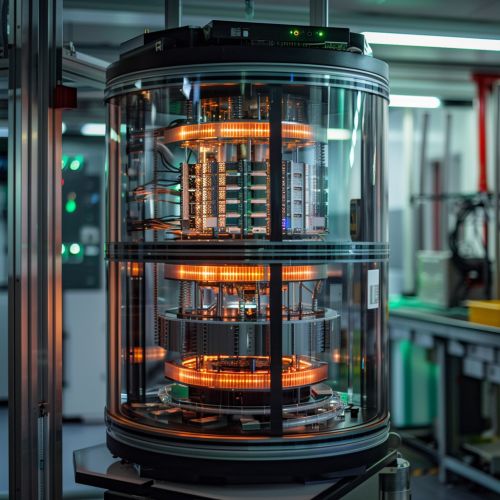Quantum Information Technology: Difference between revisions
(Created page with "== Introduction == Quantum Information Technology (QIT) is an interdisciplinary field that merges principles of quantum mechanics with information theory to develop new technologies for computation, communication, and cryptography. Unlike classical information technology, which relies on bits as the fundamental unit of information, QIT uses quantum bits or qubits. These qubits exploit the phenomena of superposition and entanglement to perform operations that are infeasib...") |
No edit summary |
||
| Line 59: | Line 59: | ||
Future research aims to address these challenges and unlock the full potential of QIT. | Future research aims to address these challenges and unlock the full potential of QIT. | ||
[[Image:Detail-92829.jpg|thumb|center|A visually appealing image of a quantum computer in a laboratory setting.|class=only_on_mobile]] | |||
[[Image:Detail-92830.jpg|thumb|center|A visually appealing image of a quantum computer in a laboratory setting.|class=only_on_desktop]] | |||
== See Also == | == See Also == | ||
Latest revision as of 15:20, 21 June 2024
Introduction
Quantum Information Technology (QIT) is an interdisciplinary field that merges principles of quantum mechanics with information theory to develop new technologies for computation, communication, and cryptography. Unlike classical information technology, which relies on bits as the fundamental unit of information, QIT uses quantum bits or qubits. These qubits exploit the phenomena of superposition and entanglement to perform operations that are infeasible for classical systems.
Quantum Mechanics and Information Theory
Quantum mechanics is the branch of physics that deals with the behavior of particles at atomic and subatomic scales. It introduces concepts such as wave-particle duality, uncertainty principle, and quantum state. Information theory, on the other hand, is a mathematical framework for quantifying information, primarily developed by Claude Shannon. It includes concepts like entropy, data compression, and error correction.
In QIT, these two fields converge to redefine how information is processed and transmitted. The fundamental unit of quantum information is the qubit, which can exist in a superposition of states, unlike a classical bit that is either 0 or 1.
Qubits and Quantum Gates
A qubit is the basic unit of quantum information, represented by a two-level quantum system. It can be in a state |0⟩, |1⟩, or any superposition α|0⟩ + β|1⟩, where α and β are complex numbers satisfying |α|² + |β|² = 1. This property enables quantum computers to perform many calculations simultaneously.
Quantum gates manipulate qubits through unitary operations. Common quantum gates include the Pauli-X, Pauli-Y, Pauli-Z, Hadamard, and CNOT gates. These gates form the building blocks of quantum circuits, analogous to classical logic gates in conventional circuits.
Quantum Entanglement
Quantum entanglement is a phenomenon where qubits become interconnected such that the state of one qubit directly affects the state of another, regardless of the distance separating them. This property is crucial for quantum communication and quantum computing. Entangled states are used in protocols like quantum teleportation and superdense coding.
Quantum Algorithms
Quantum algorithms leverage the principles of quantum mechanics to solve problems more efficiently than classical algorithms. Notable examples include:
- **Shor's Algorithm**: Efficiently factors large integers, undermining the security of classical cryptographic systems.
- **Grover's Algorithm**: Provides a quadratic speedup for unstructured search problems.
- **Quantum Fourier Transform (QFT)**: A key component in many quantum algorithms, including Shor's algorithm.
These algorithms demonstrate the potential of quantum computers to outperform classical computers in specific tasks.
Quantum Cryptography
Quantum cryptography utilizes the principles of quantum mechanics to secure communication. The most well-known application is Quantum Key Distribution (QKD), specifically the BB84 protocol. QKD allows two parties to generate a shared, secret key with security guaranteed by the laws of quantum mechanics. Any attempt to eavesdrop on the key exchange introduces detectable disturbances.
Quantum Communication
Quantum communication involves the transmission of quantum states between distant locations. It relies on quantum entanglement and QKD to ensure secure and efficient communication. Quantum repeaters are used to extend the range of quantum communication networks by overcoming the limitations of direct transmission.
Quantum Computing Hardware
Building a practical quantum computer requires controlling and maintaining qubits in a coherent state. Various physical systems are being explored for qubit implementation, including:
- **Superconducting Qubits**: Utilize Josephson junctions and are currently the most advanced in terms of scalability and coherence times.
- **Trapped Ions**: Use electromagnetic fields to trap and manipulate individual ions, offering high-fidelity operations.
- **Topological Qubits**: Exploit exotic states of matter to provide inherent error resistance.
Each technology has its advantages and challenges, and ongoing research aims to identify the most viable approach for large-scale quantum computing.
Quantum Error Correction
Quantum systems are highly susceptible to errors due to decoherence and noise. Quantum error correction (QEC) is essential for reliable quantum computation. QEC codes, such as the Shor Code and Steane Code, protect quantum information by encoding it into entangled states of multiple qubits. Fault-tolerant quantum computation ensures that errors can be corrected without disrupting the computation process.
Applications of Quantum Information Technology
QIT has the potential to revolutionize various fields:
- **Cryptography**: Quantum cryptographic protocols offer unprecedented security.
- **Optimization**: Quantum algorithms can solve complex optimization problems more efficiently.
- **Material Science**: Quantum simulations can model molecular and atomic interactions with high precision.
- **Artificial Intelligence**: Quantum machine learning algorithms promise faster training and better performance.
Challenges and Future Directions
Despite significant progress, several challenges remain in the development of QIT:
- **Scalability**: Building large-scale quantum computers with millions of qubits.
- **Error Rates**: Reducing error rates to achieve fault-tolerant quantum computation.
- **Interfacing**: Developing efficient interfaces between quantum and classical systems.
Future research aims to address these challenges and unlock the full potential of QIT.


See Also
- Quantum Mechanics
- Information Theory
- Quantum Cryptography
- Quantum Computing
- Quantum Entanglement
- Quantum Algorithms
